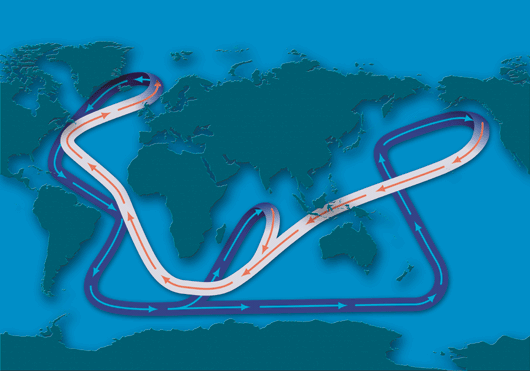Kinks Found In Ocean's 'Conveyor Belt'


The water that fills the oceans doesn't stay in the same place from year to year — huge ocean-wide patterns of circulation slowly cycle that water around the world over the course of thousands of years.
Until now, oceanographers have subscribed to the overarching view that a conveyor belt-like system circulates the ocean waters from the poles to the equator and back again. Scientists have known that this was an oversimplification, and new research is showing where the ocean superhighway takes some unexpected twists and turns.
Scientists have found evidence that the ocean currents move on different pathways than previously thought, said M. Susan Lozier of Duke University in Durham, N.C., and author of a review of ocean circulation research detailed in the June 18 issue of the journal Science.
The basic global conveyor belt theory works like this: Warm surface water flows poleward from the tropics and cools, becoming denser and eventually sinking when it reaches the North Atlantic. The cooled water then returns along the bottom of the ocean to the tropics. It's this circulation that is thought to help redistribute heat around the planet.
"There's no doubt there is an overturning, we can see the evidence of it," said oceanographer Joshua Willis of NASA's Jet Propulsion Laboratory in Pasadena, Calif., who was not involved with the study. "We can actually measure it, but the details are very complicated. There's not a simple conveyor belt."
Recent research has shown that parts of the belt are interrupted by eddies — whirlpools of water that are several hundred kilometers in diameter. Also, winds have been revealed to play a larger role in overturning the waters.
Models now show that eddies can drive the recirculation of water on pathways other than the conveyor belt, Lozier said. Eddies in the Southern Ocean are one example of a terrific water mixer that influences other water masses, said Ronald Stouffer of the U.S. National Oceanic and Atmospheric Administration.
Get the world’s most fascinating discoveries delivered straight to your inbox.
Having an accurate picture of the way the oceans' water moves around the planet is important because scientists say that it could be influenced by climate change. Because human-induced global warming seems to be increasing temperatures most rapidly at the poles, the air above the water will warm it up, preventing the water from cooling and sinking, which could cause a disruption to the ocean's circulation. Rethinking how the ocean's water mixes doesn't change this prediction; it helps scientists shine their flashlight on the areas where water mixing might slow down.
"Our new understanding gives us a better idea of how to — and where to — monitor the overturning," Lozier told OurAmazingPlanet.
Scientists plunk high-tech floats in the water and track their movements to understand the pathways of the upper and lower limbs of the world's ocean’s overturning. These measurements will aid assessments of the ocean’s role in the uptake, transport and storage of heat and carbon dioxide, all crucial components of Earth’s climate system.
"As the study of the modern ocean’s role in climate continues apace, the conveyor belt model no longer serves the community well — not because it is a gross oversimplification but because it ignores crucial structure and mechanics of the ocean’s intricate global overturning," Lozier wrote in her review.
Despite predictions that water mixing at the ends of the conveyor belt may slow down, there's no evidence that this is occurring, at least over the last five to 15 years, Willis said.


